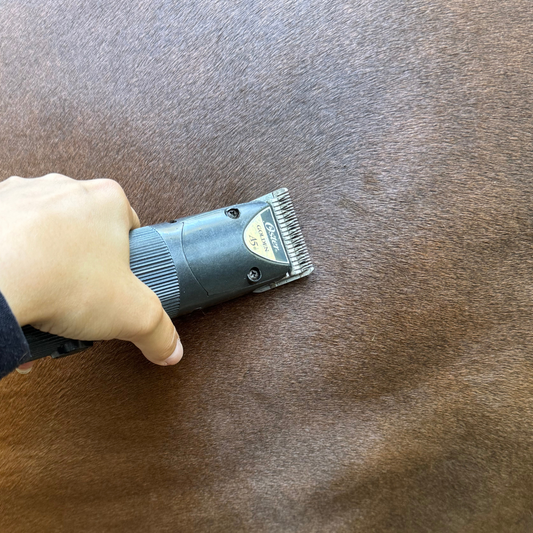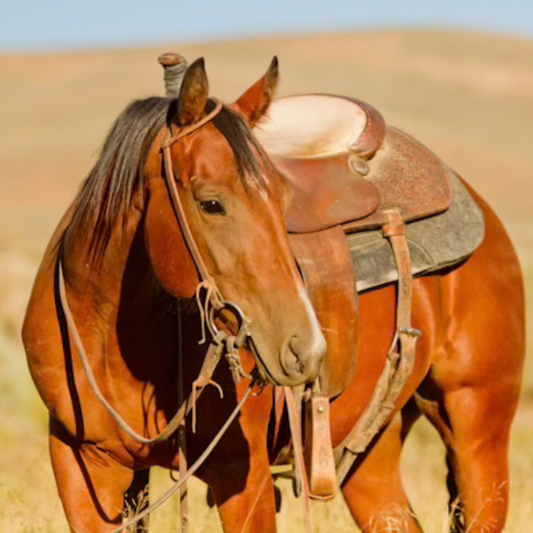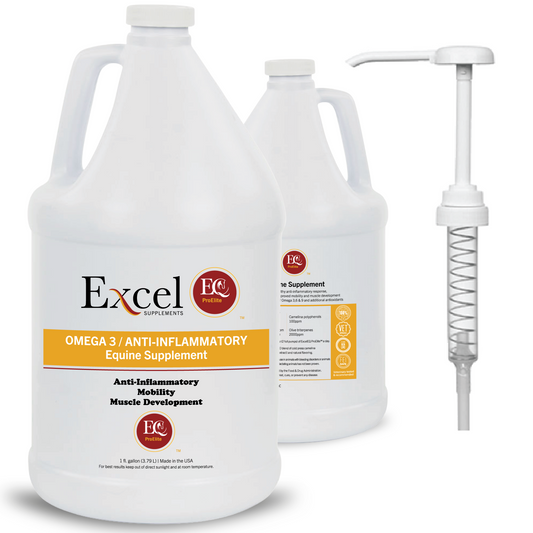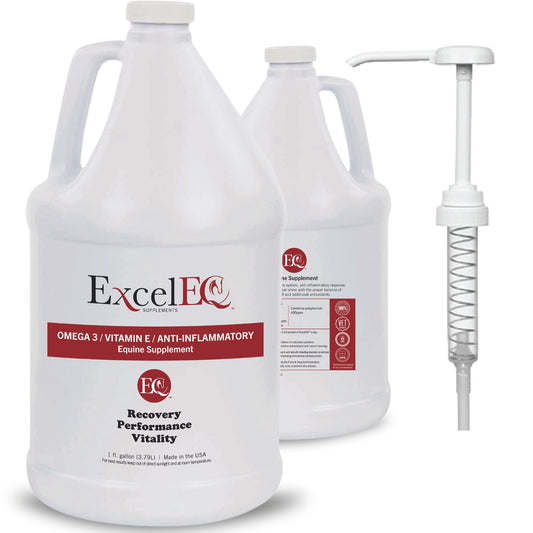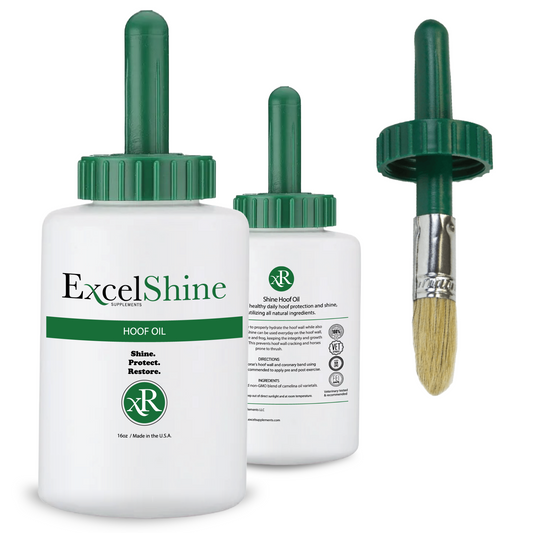Clostridial Myositis
Share
Clostridial Myositis Fasciitis Warning Signs
Every year, when I bring my broodmares in to foal out, I realize how lucky I am to still have I Sayo I Love You. "Love" is one of my very favorite mares and the thought that I almost lost her as a yearling to Clostridial Myositis is a scary every time.
This is not related to Excel Supplements but as a horse owner/breeder I sure wish I would have known. I also wish I would have had ExcelEQ ProElite to feed her at the time to boost her system. Pass this on to your horse friends. It will eliminate a lot of trial and error.
So here starts my story with Clostridial Myositis
A couple of winters ago I had two coming yearlings, I Sayo I Love You and Ima Smokin Sayo, and a coming two year old filly, Smart N Lil Lena. All come up with a bit of a cold after a few days of rain that later turned into a freezing snow. Feeling bad for these guys I brought them in from the pasture and gave them some Banamine to make them feel a bit better. Trying to make the Banamine last longer I thought I would do them a great favor by giving it in the muscle. Well boy was I wrong.
By the next morning I found Smart N Lil Lena
dead in her stall.
Within a few days they all three developed swelling on the side of the neck that I had given the shot to and I Sayo I Love You and Smart N Lil Lena both became very stiff in the neck, carrying their heads low, not eating, and just feeling plumb miserable. By the next morning I found Smart N Lil Lena dead in her stall. Was it a bad bottle of Banamine? Ima Smokin Sayo's swelling went down a few days after that and he returned to normal. I Sayo I Love you also returned to normal other then a hard lump on her neck. In the spring the hard lump on her neck finally got a soft spot. I lanced it and drained it. All that remains is a little scar on her neck.
Visiting with a vet in AZ years later I finally got an answer. Clostridial Myositis Fasciitis was the cause! You should NEVER give Banamine in the muscle as you can kill your horse that way.
Take the time and read on and I hope you all get some good out of this and do not have to learn the hard way.
As reported by the Bend Equine Medical Center
Malcom is a 14 year old Quarter Horse gelding who presented to Bend Equine for a firm swelling on his neck after receiving 10ml of Banamine in the muscle yesterday morning for mild colic symptoms. On presentation Malcom had a fever of 103.5 F. He was lethargic and inappetant and the swelling was firm and hot to the touch. Ultrasound images of the swelling showed pockets of fluid and white flecks indicating gas bubbles in the muscle. These findings indicate an abscess had formed from an anaerobic bacteria that produces gas. Anaerobic bacteria are a type of bacteria that can only survive in environments without air. An incision was made via ultrasound guidance deep into the muscle tissue to both drain the abscess and expose the bacteria to air.
Over the course of the next 10 of days Malcom continued to be ill . He was on full ICU supportive care but was still spiking fevers twice daily. Malcom had numerous surgical procedures in attempt to stop the spread of the bacteria and save his life. This was no ordinary bacteria causing these symptoms! Does anyone have any ideas what is the name of the disease causing Malcom’s illness? What are the predisposing factors for this type of disease?
Here is your Answer
Why to NEVER, EVER administer Banamine into the muscle of a horse….
Clostridial Myositis Fasciitis secondary to intra-muscular administration of Banamine. Clostridial Myositis (also known as gas gangrene) is a very rare disease however it is far more likely to occur when certain substances are injected into the muscle.
The top 3 culprits are Banamine (flunixin meglumine), ivermectin and anti-histamines. Clostridium is a bacteria which spores exist everywhere in our environment- soil, skin, debris etc. When the spores sense that they are in an environment without air they sporulate, reproduce and start to produce exotoxin. This exotoxin is extremely toxic to the surrounding tissue causing death and massive inflammatory reactions of the muscle, skin and whole body. The Clostridium bacteria spreads rapidly and causes the horse to become very systemically ill. Surgical exposure of the bacteria to oxygen, appropriate antibiotics, and supportive care are the cornerstones of therapy however, even with the best of care 40-70% of these horses will die or be euthanized. Those that survive acquire thousands of dollars of hospital bills and endure a long and painful illness.
The veterinary community does not fully understand the mechanism for why these drugs cause this particular infection however it is related to the fact that they are all severely irritating substances that cause a significant amount of local inflammation when injected intramuscularly.
We are happy to report that with a tremendous amount veterinary care, wonderfully supportive owners and a 3-week stay at Bend Equine, Malcolm survived his infection and went home happy and healthy!
TAKEAWAYS
- Clostridial Myositis is NOT a condition where an injection site abscess is left to sit too long and gets out of control. This horse was brought in at the slightest hint of swelling and he was treated immediately. This is a special kind of bacteria that is particularly fast spreading and dangerous. As mentioned in your responses, it can occur with other types of injectables. However it is FAR more likely to happen with Banamine due to the highly inflammatory nature of it.
- Believe it or not, proper cleaning of the injection site does not reduce the risk of this disease from occurring. We wish it were that simple! We of course encourage cleaning an injection site and recommend ALWAYS using clean needles. No negligence was to blame which is why this is an important topic to get out there!
- It is a common occurrence for horses to develop localized swelling at an injection site (ie after vaccines). We do not wish to cause undo fear in people with this case. Clostridial infections are no ordinary injection site abscess/inflammation. They are associated with Banamine intramuscular injections. We encourage you to take injection site inflammation seriously and have your horse seen by a veterinarian should it occur.


